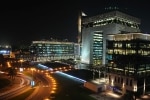Executive summary
Military commanders and planners in the Middle East and North Africa (MENA) often do not have a clear or accurate understanding of the readiness of their forces. They strive to maintain extremely high levels of force readiness, yet those standards are often unrealistic, unattainable, and unsustainable. Leaders often focus only on the availability of equipment such as weapons platforms and systems, which does not provide the overall picture of readiness.
If MENA armed forces are to meet their commitments, they need a more comprehensive approach to military readiness and force generation. This starts with an assessment of the core objectives: the threats that militaries must address, and the country’s foreign policy stance, alliance obligations, and non-defence missions (such as humanitarian or disaster relief) that a military supports. With greater detail, commanders and planners must consider each actual mission, including such parameters as mission duration, destination, intensity, and logistics.
With this information militaries can develop a readiness program that goes beyond the current “yes-or-no” determination. Instead, it will allow units to cycle through predictable states of readiness: low, medium, and high. In each state, commanders should factor in all dimensions of readiness: personnel, equipment, training, and sustainability. The best approach will put all of this information into commanders’ hands through a dashboard that offers an accurate, current indication of readiness and allows leaders to test scenarios and identify potential ramifications. At a more sophisticated level, it can predict readiness at future points in time by factoring in considerations such as manpower forecasts and equipment overhaul schedules.
In this new system, armed forces will report that they are not ready on the old standard, which at first glance may appear unacceptable. However, setting a predictable readiness cycles means that these new reported levels will be feasible and realistic. This will result in a sustainable approach to readiness that should allow armed forces to respond appropriately to the wide range of threats and challenges which are likely to occur.
No clear picture of readiness
Military commanders and planners in the MENA region are often fixated on the goal of keeping forces at a high state of readiness. Their logic is that higher levels are better. Instead, this approach leads to much higher logistics and sustainment costs, and estimates that are inflated, masking the true readiness level of forces. For military leaders and governments, the more critical risk is that they will make deployment and operational decisions based on a false sense of their militaries’ true readiness. In extreme cases, this can lead to prolonged or failed missions, a national loss of face, and needless casualties.
The underlying problem is that many commanders and planners focus primarily on the technical status of equipment such as weapons platforms and systems, rather than the operational status of their forces. In doing so, they often fail to consider other factors, such as personnel, training, equipment maintenance and repair, and logistics.
For example, consider a military that purchases 20 new fighter jets. Commanders and planners might logically assume that all 20 are ready to fly, meaning they are all at high readiness. However, there are other factors to consider. Does the force have enough pilots sufficiently trained and certified to fly the aircraft? Have these pilots conducted training in group formations, and with other branches? Can logistics functions deliver fuel, parts, and other needed materiel to them? When will they require scheduled maintenance? Can the military plan in advance for inevitable unscheduled maintenance?
Of course, it is rare for militaries to receive new equipment in a block like this. More commonly, equipment is at different stages of its service life. This adds another dimension to readiness. Even if equipment is operational today, it may be two months away from its next required overhaul, or it could be weeks from the end of its operational use — meaning that it is not available for a three-month deployment.
Personnel readiness has similar complications. Units need to absorb new recruits, rotate troops out for skills training courses, and simply rest and recover after returning from operations, as well as retiring those who have completed their military service. Moreover, practical aspects affect readiness at a force level. For example, it can take up to 30 days to arrange transport shipping from the international maritime market. Even for heavy-lift civilian cargo aircraft, 10 days is typical. Given such a time lag, there is little point in keeping forces on seven days’ notice to move; it is not physically possible to transport them within that window.
For commanders and planners in the MENA region, a more comprehensive approach factors in these elements and establishes several levels of readiness, some of which will be lower than at present, but are more accurate, feasible, and sustainable over time. Instead of the current level of readiness that pretends to provide a large available force to commanders, but in practice does not, MENA region militaries will have a keen awareness of their true readiness and capacity to fulfil their missions.
The current level of readiness pretends to provide a large available force to commanders.
Conclusion
There is a clear benefit for MENA region armed forces from assessing and reporting readiness in a realistic, comprehensive, and accurate manner, considering the military’s objectives and specific mission parameters, for personnel, equipment, training, and sustainability. Such an approach further assists commanders and planners by grouping forces into a predictable cycle from low to high readiness. The model of readiness gives military planners and decision makers accurate information, allowing them to make informed decisions about the use of forces. Ultimately, the payoff will come through a military that embarks on missions and deployments with the elements required for success.
Contact us













Menu